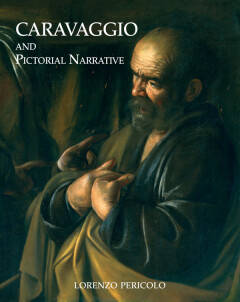
En raison d'une grêve chez bpost, votre commande pourrait être retardée. Vous avez besoin d’un livre rapidement ? Nos magasins vous accueillent à bras ouverts !
- Retrait gratuit dans votre magasin Club
- 7.000.000 titres dans notre catalogue
- Payer en toute sécurité
- Toujours un magasin près de chez vous
En raison de la grêve chez bpost, votre commande pourrait être retardée. Vous avez besoin d’un livre rapidement ? Nos magasins vous accueillent à bras ouverts !
- Retrait gratuit dans votre magasin Club
- 7.000.0000 titres dans notre catalogue
- Payer en toute sécurité
- Toujours un magasin près de chez vous
Caravaggio and Pictorial Narrative
Dislocating the Istoria in Early Modern Painting
Lorenzo Pericolo
Livre relié | Anglais
318,95 €
+ 637 points
Description
Truly a distinguished achievement, this book is required reading for general readers as well as specialists in the history of art (Charles Dempsey, The Johns Hopkins University)A very important part of Caravaggio's production consists of pictorial narratives, mostly religious. Thus, according to early modern aesthetics, Caravaggio practiced the artistic genre of the istoria: the most discussed and thoroughly defined pictorial institution of his time. Unanimously, seventeenth-century artists and art theorists censored and condemned Caravaggio's art for its numerous deficiencies and faults in regard to the principles of the istoria. In spite of all these testimonies, Caravaggio's innovations in and misuses of the techniques specific to early modern pictorial narrative have never been systematically studied, debated, and put into historical perspective. In this volume, Lorenzo Pericolo argues that Caravaggio's multiple experimentations with the traditional devices of the istoria not only represent the core of an unprecedented poetics of dislocation, but also unsettled, dismantled, and expanded the scope of pictorial narrative in ways that would have redefined and deeply transformed the concept of painting and artistic creation, had Caravaggio's enterprise not have been ferociously criticized and stigmatized as both aberrant and defective. To solidly establish the importance and groundbreaking charge of Caravaggio's work, Pericolo examines the notion of Leon Battista Alberti's istoria as interpreted and developed by early modern artists and theorists-from Leonardo to Vasari, from Lomazzo to Poussin, and from Michelangelo to Bellori-in vast surveys in which the concepts of diachrony, duration, eurythmy, propriety, verisimilitude, and pictorial truth- among others-are carefully examined on a theoretical and practical level. By analyzing the paintings of Caravaggio's followers such as Cecco del Caravaggio, Battistello Caracciolo, Valentin de Boulogne and, not least, Diego Velazquez, Pericolo explores how Caravaggio's innovations in the domain of pictorial narrative were variously construed, elaborated upon, and brought to fruition in the aftermath of the master's death in 1610, thereby offering a critical explanation of the implosion and extinction of the Caravaggesque movement in the 1630s.
Spécifications
Parties prenantes
- Auteur(s) :
- Editeur:
Contenu
- Nombre de pages :
- 654
- Langue:
- Anglais
Caractéristiques
- EAN:
- 9781905375486
- Date de parution :
- 23-09-11
- Format:
- Livre relié
- Format numérique:
- Genaaid
- Dimensions :
- 231 mm x 305 mm
- Poids :
- 3152 g

Les avis
Nous publions uniquement les avis qui respectent les conditions requises. Consultez nos conditions pour les avis.






